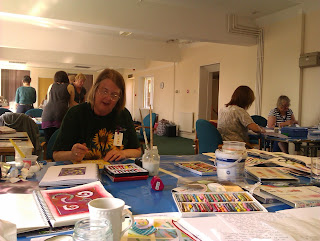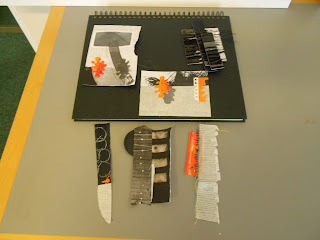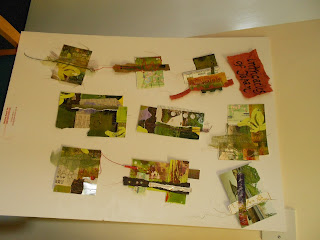Chapter 2
I received as a birthday present a wonderful book,
Collage, Stitch, Print by Val Holmes (Batsford 2012, ISBN 978 1 84994 014 6) which inspired me to give the technique a try. It would take many months to fully experiment with all the ideas in the book, but I thought the relief in some of my collages for Chapter 2 might be deep enough to make a collagraph plate. I sealed the surface with pva and rolled acrylic paint on with a brayer. I mixed various combinations of my chosen colour scheme and produced a series of prints as shown below.
 |
| 3.2.c1 |
 |
3.2.c2
|
 |
3.2.c3
|
 |
3.2.c4
|
 |
3.2.c5
|
 |
3.2.c6
|
Below is a photograph of the plate used after making the prints. It makes an interesting example on its own.
 |
3.2.c7
|
I was so pleased with this technique that I tried the same method with another collage I had made.
 |
3.2.c8
|
 |
3.2.c9
|
 |
3.2.c10
|
 |
3.2.c11 the plate after the prints had been made
|
 |
3.2.c12
|
I was doing these prints literally as I was packing the materials I needed for Summer School. I took them with me to show Sian, but hadn't time until now to post them on my blog. I look forward to exploring this technique further, in particular, using stitch to make texture on the plate, as demonstrated by Val Holmes in her book.
Chapter 3
Here is work that I have done since coming home from Summer School. I began on Chapter 3 of Module 3 by colouring some fabrics. I used fabric paints (Dye-na-Flow) and acrylic paint mixed with fabric medium. This gave good results, much quicker and easier than using dye. I intend to re-visit this exercise in the future, since I had only a limited range of fabrics at home and because I'd like to try again some of the shibori techniques from Module 2. However, my fingers are itching to get stitching so I went for speedy results. Here are my coloured fabrics, hanging on the line to dry and then dried, ironed and folded.
To add to them, I had some shibori fabrics left over from Module 2 as well as dyed and printed fabrics from other projects. I also bought some dyed fabric while in Malvern on holiday from a lovely shop called Stitch 45.
Someone mentioned at Summer School that if you mix fabric paint with aloe vera gel then it does not spread on fabric and you get a clean line. I tried it with Dye-na-Flow on a sheer, metallic polyester with quite pleasing results.
 |
3.3.aloe 1
|
 |
3.3.aloe 2
|
I am becoming hooked on monoprinting. I love it. I had fun monoprinting some of my fabrics.
 |
3.3.m1 on a left over piece of printed fabric
|
 |
| 3.3.m2 on acrylic felt |
 |
| 3.3.m3 on acrylic felt |
 |
3.3.m4 on polyester sheer metallic fabric
|
 |
3.3.m5 on polyester sheer
|
 |
3.3.m6 on dyed cheesecloth
|
 |
| 3.3.m7 on cotton muslin |
I also had some fabrics I had printed at Summer School with Sue Dove.
 |
3.3.m8 on previously shibori dyed and block printed cotton
|
 |
3.3.m9 on a digital print on cotton that didn't work out. It does now I think.
|
Three of the summer school monoprints were a bit pale, being on plain white cotton and so I mixed up some dilute acrylic paint with fabric medium and brushed it over the monoprint. It worked well, the print easily showing up through the transparent wash.
 |
| 3.3.m10 on cotton |
 |
| 3.3.m11 on cotton |
 |
3.3.m12 on cotton
|
What a wonderfully rich creative time I am having. More riches to look forward to with a two-day workshop with Alison King on Tuesday and Wednesday of this week. My cup runneth over.
















































































































